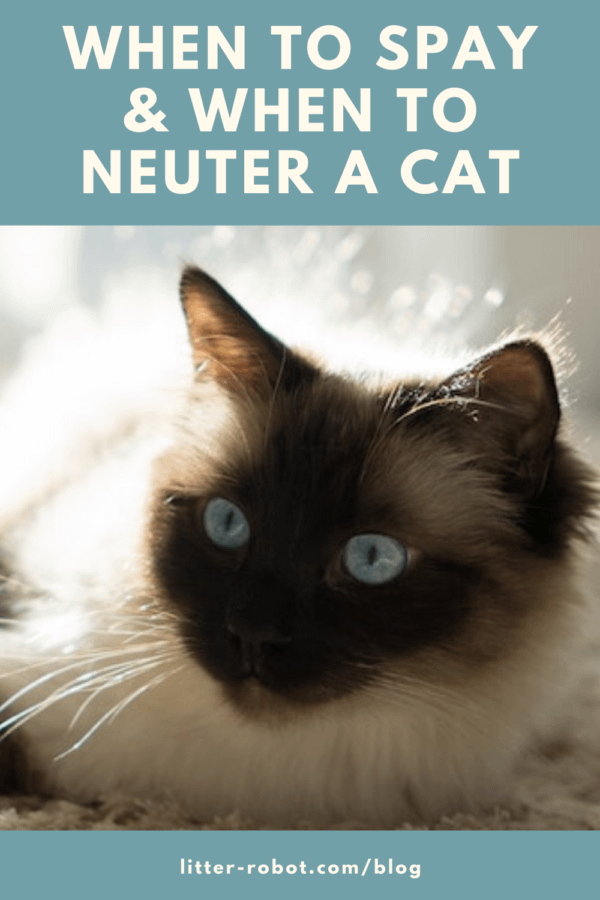Did you know that February is both Spay Neuter Awareness Month and Responsible Pet Owners Month? As a veterinarian, I often get asked when to spay and when to neuter a cat or dog. For the past few decades, the general recommendation for both dogs and cats has always been around 6 months of age—but before the first heat (e.g., period) cycle. There are typically 3 scenarios for timing of spay neuter:
- Early spay neuter (less than 8 weeks of age) is typically done by rescues and animal shelters before the pet is adopted out, in an attempt to minimize pet overpopulation.
- Standard spay neuter (at 5-6 months of age) is typically what most veterinarians recommend—especially for cats.
- Delayed spay neuter (after the first heat) is typically done only for dogs—not cats.
What is a spay and neuter?
First of all, what exactly is spaying and neutering? When we use the medical term “spay,” it means to surgically remove a female’s ovaries and uterus. To “neuter” means to surgically remove the male’s testes.
When to spay a cat and when to neuter a cat
The general recommendation on when to spay and neuter cats is to “Fix Felines by Five”—in other words, by 5 months of age. Why earlier in cats? Female cats can go into their first heat cycle as young as 4 months of age, but typically around 5-6 months of age. This is typically earlier than dogs. So, make sure to “Beat the heat!”, as that first spring is when unspayed females go into heat. Believe it or not, but it’s okay to spay when a cat weighs as little as 2 pounds, which correlates with 2 months.
Benefits of an early spay and neuter
There are several benefits of why to spay and neuter early. These include:
- Reducing the risk of pet overpopulation (helps prevent unwanted litters)
- Helping improve overall health (reducing risks of mammary/breast cancer). Breast cancer in cats is malignant/aggressive in 90% of cats and fatal
- Helping eliminate unwanted behavioral issues (like spraying, howling, going into heat, fighting, defending their territory, wanting to escape, inappropriate urination)
- Faster surgical procedures
- Shorter surgical and anesthesia times
- Better intra-abdominal visualization (because they are smaller and there is less abdominal fat)
- Faster recovery—with good pain control, heat support, and monitoring, cats bounce back quickly from surgery
- Less bleeding
- Did I mention that it helps reduce the smelly behavior of spraying urine all over your walls?!
- Helping your cat potentially live longer
Avoiding euthanasia
The main reason why I’m passionate about spaying and neutering by 5 months in cats is because of euthanasia. As a veterinarian, I see a lot of animals euthanized due to pet overpopulation. Cats can reproduce all year round (any farmer will attest to this!), but spring and summer is the notorious “kitten season” (during warmer weather).
Most people aren’t aware that an estimated 41-75% of cats that go into animal shelters each year are euthanized. That’s estimated to be 3-4 million cats a year, which breaks my heart. One cat can produce hundreds of kittens, which then go on to promote hundreds more kittens… and there’s an explosion in cat overpopulation.
In the past, I’ve had pet parents bring their cats into the veterinary ER because they thought something was wrong with their cat. After paying $120 for an exam fee, they find out the annoying crying, constant clinginess, erratic behavior, howling, and rolling on the side is actually not an emergency… but a heat cycle. They want their cat spayed immediately—but we don’t do this unless it’s an emergency. There’s more vasculature (e.g., blood vessels and blood flow) to the ovaries and uterus, and it’s a more expensive, longer surgery, as the tissue is more delicate. So the cat parents just have to put up with this behavior for a few more weeks! Good luck with that!
More reasons to “Fix Felines by Five”
Responsible pet ownership and spaying/neutering also:
- Helps the community by reducing the number of unwanted cats
- Reduces risks of hoarding and overabundance of cats
- Frees up shelter resources that can be used to help more animals
- Prevents risks of infections in the environment
- Potentially minimizes the risk of Toxoplasma being shed in the environment in outdoor stray cats
What’s more, spaying and neutering can help you!
- It can save money on emergency reproductive disorders like an infected uterus (e.g., pyometra)
- Spaying and neutering can save you time on trying to find homes for 6-8 kittens
- It can save you money on a veterinary visit to test all your kittens for feline kitty AIDS (e.g., FeLV/FIV), deworm them, and give them their first 2 shots before you adopt them out
There are several reputable organizations that endorse and support early spay neuter in cats, and these include:
- Alley Cat Allies (alleycat.org)
- American Animal Hospital Association (aaha.org)
- The American Association of Feline Practitioners (AAFP.org)
- American College of Theriogenologists (therio.org)
- The American Humane Society
- American Society for the Prevention of Cruelty to Animals (ASPCA.org)
- The American Veterinary Medical Association
- Association of Shelter Veterinarians (sheltervet.org)
- CATalyst Council (catalystcouncil.org)
- Cat Fanciers Association (cfa.org)
- Winn Feline Foundation (winnfelinefoundation.org)
When in doubt, discuss this with your veterinarian and keep your cat healthy and happy. But try to “Beat the heat” and “Fix Felines by Five!”
If you own multiple cats and have trouble caring for them, our guide for managing multi-cat households gives tips and information on owning multiple cats.
What about when to spay and neuter a dog?
More recently, there’s controversy on the exact age to spay and neuter dogs. Recent studies out of UC Davis in Golden Retrievers have suggested that spaying or neutering later in life may have some health benefits. However, this is a limited study that only looks at one breed of dog, and is likely influenced by some other outside factors (environmental, socioeconomic, etc.). My philosophy? When the growth plates are almost closed, which is very dependent on the size of the dog (e.g., growth plates will close more slowly in huge, giant breed dogs and close sooner in small teacup-sized dogs). But there are no studies to support delayed spay neuter in our feline friends.
References:
- Association of Shelter Veterinarians’ Veterinary Task Force to Advance Spay-Neuter. Special report: The Association of Shelter Veterinarians’ 2016 veterinary medical care guidelines for spay-neuter programs. JAVMA. 2016;249(2):165-188.
- American Association of Feline Practitioners. AAFP Position statement: Early spay and castration. AAFP website. http://www.catvets.com/public/PDFs/PositionStatements/EarlySpay&Neuter.pdf. Accessed April 28, 2017.
- Root Kustriz MV. Early spay-neuter: Clinical considerations. Clin Tech Small Anim Prac 2002;17:12-128.
Cover photo by David Köhler on Unsplash









